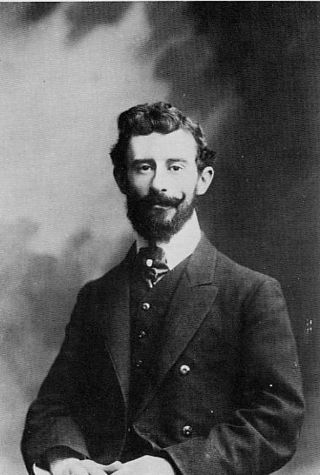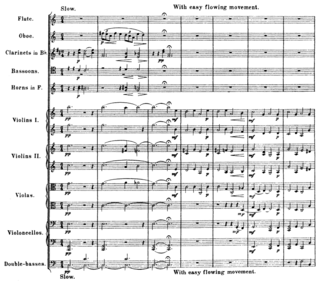Related Research Articles

Miroirs is a five-movement suite for solo piano written by French composer Maurice Ravel between 1904 and 1905. First performed by Ricardo Viñes in 1906, Miroirs contains five movements, each dedicated to a fellow member of the French avant-garde artist group Les Apaches.

The bass oboe or baritone oboe is a double reed instrument in the woodwind family. It is essentially twice the size of a regular (soprano) oboe so it sounds an octave lower; it has a deep, full tone somewhat akin to that of its higher-pitched cousin, the English horn. The bass oboe is notated in the treble clef, sounding one octave lower than written. Its lowest sounding note is B2 (in scientific pitch notation), one octave and a semitone below middle C, although an extension with an additional key may be inserted between the lower joint and bell of the instrument in order to produce a low B♭2. The instrument's bocal or crook first curves away from and then toward the player (unlike the bocal/crook of the English horn and oboe d'amore), looking rather like a flattened metal question mark; another crook design resembles the shape of a bass clarinet neckpiece. The bass oboe uses its own double reed, similar to but larger than that of the English horn.
Alan Ridout was a British composer and teacher.

John Mervyn Addison was a British composer best known for his film scores.
Walter Sinclair Hartley was an American composer of contemporary classical music.
The Bachianas Brasileiras are a series of nine suites by the Brazilian composer Heitor Villa-Lobos, written for various combinations of instruments and voices between 1930 and 1945. They represent a fusion of Brazilian folk and popular music on the one hand and the style of Johann Sebastian Bach on the other, as an attempt to freely adapt a number of Baroque harmonic and contrapuntal procedures to Brazilian music. Most of the movements in each suite have two titles: one "Bachian", the other Brazilian.

On Hearing the First Cuckoo in Spring is a tone poem composed in 1912 by Frederick Delius. Together with Summer Night on the River it is one of Delius's Two Pieces for Small Orchestra. The two were first performed in Leipzig on 23 October 1913, conducted by Arthur Nikisch. On Hearing the First Cuckoo in Spring is the longer of the two pieces, with a typical playing time of between six and seven minutes. There have been numerous recordings of the piece, which Delius's champion Sir Thomas Beecham described as much the best known of the composer's works.
Stefans Grové was a South African composer. Before his death the following assessment was made of him: "He is regarded by many as Africa's greatest living composer, possesses one of the most distinctive compositional voices of our time".

Donald Henry Kay AM is an Australian classical composer.
Metropolis Symphony for Orchestra (1988–93) by American composer Michael Daugherty is a five-movement symphony inspired by Superman comics. The entire piece was created over the span of five years with separate commissions for each movement. Individual movements may be performed separately; however, it is preferred that the 41 minute symphony be performed in its entirety. MetropolisSymphony was premiered by the New Hampshire Symphony Orchestra, James Bolle conducting, in November 1993, at the Palace Theater in Manchester, New Hampshire. A connective narrative between movements was written and read by Jack Larson, who had played Jimmy Olsen on television in The Adventures of Superman. The orchestral version without narration was premiered by the Baltimore Symphony Orchestra, David Zinman conducting, in January 1994, at the Meyerhoff Concert Hall in Baltimore, Maryland.
Rustic Wedding Symphony, Op. 26 is a symphony in E-flat major by Karl Goldmark, written in 1875, a year before his renowned Violin Concerto No. 1. The symphony was premiered in Vienna on 5 March 1876, conducted by Hans Richter. Johannes Brahms, who was a frequent walking companion of Goldmark's, and whose own Symphony No. 1 was not premiered until November 1876, told him "That is the best thing you have done; clear-cut and faultless, it sprang into being a finished thing, like Minerva from the head of Jupiter". Its first American performance was at a New York Philharmonic Society concert, conducted by Theodore Thomas on 13 January 1877.
William Mayer was an American composer, best known for his prize-winning opera A Death in the Family.

Colonial Song is a musical composition written by Australian composer Percy Grainger. Although Grainger created versions for different types of musical ensembles, its most commonly used version today is for concert band.

Janet Maguire (1927–2019) was an American composer who was born in Chicago and resided in Venice, Italy.
Letter from Home is a 1944 orchestral composition by Aaron Copland. The piece was commissioned as a patriotic work by Paul Whiteman for his Radio Hall of Fame Orchestra, and suggests the emotions of a soldier reading a letter from home. The music has been described as Copland's "most sentimental" and reflects his own homesickness in Mexico.
The Garden of Fand (1916) is a tone poem by the English composer Arnold Bax. It was inspired by an Irish mythical figure, Fand, the wife of the lord of the ocean. The work does not portray the events of the mythical tale, but evokes Fand's island. The composer had been greatly influenced by Celtic culture in his earlier works, but described this one as his last in that vein.

Children's March: Over the Hills and Far Away was written by Percy Grainger as his first original work for band.

Summer Night on the River is a tone poem composed in 1911 by Frederick Delius. Together with On Hearing the First Cuckoo in Spring it is one of Delius's Two Pieces for Small Orchestra. The two were first performed in Leipzig on 23 October 1913, conducted by Arthur Nikisch.
References
- ↑ Servadei, Alessandro (2008). "Percy Grainger: Orchestral works 2 (in Notes to CD Chan 9584)" (PDF). Chandos Records.
- 1 2 3 John Bird, Percy Grainger, ch. 12, "Poor Put-upon Percy", pp. 164–1656[ clarification needed ]
- ↑ "Warriors, The" by Warren Bebbington, A Dictionary of Australian Music (1998) (preview) – via Répertoire International de Littérature Musicale (rilm)
- ↑ Hyperion Records
- ↑ "Warriors. The", Wind Repertory Project
- ↑ IMSLP; The Warriors (study score). Serenissima Music. 2011. ISBN 9781932419573 – via club.be.
- ↑ "Program notes", Los Angeles Philharmonic